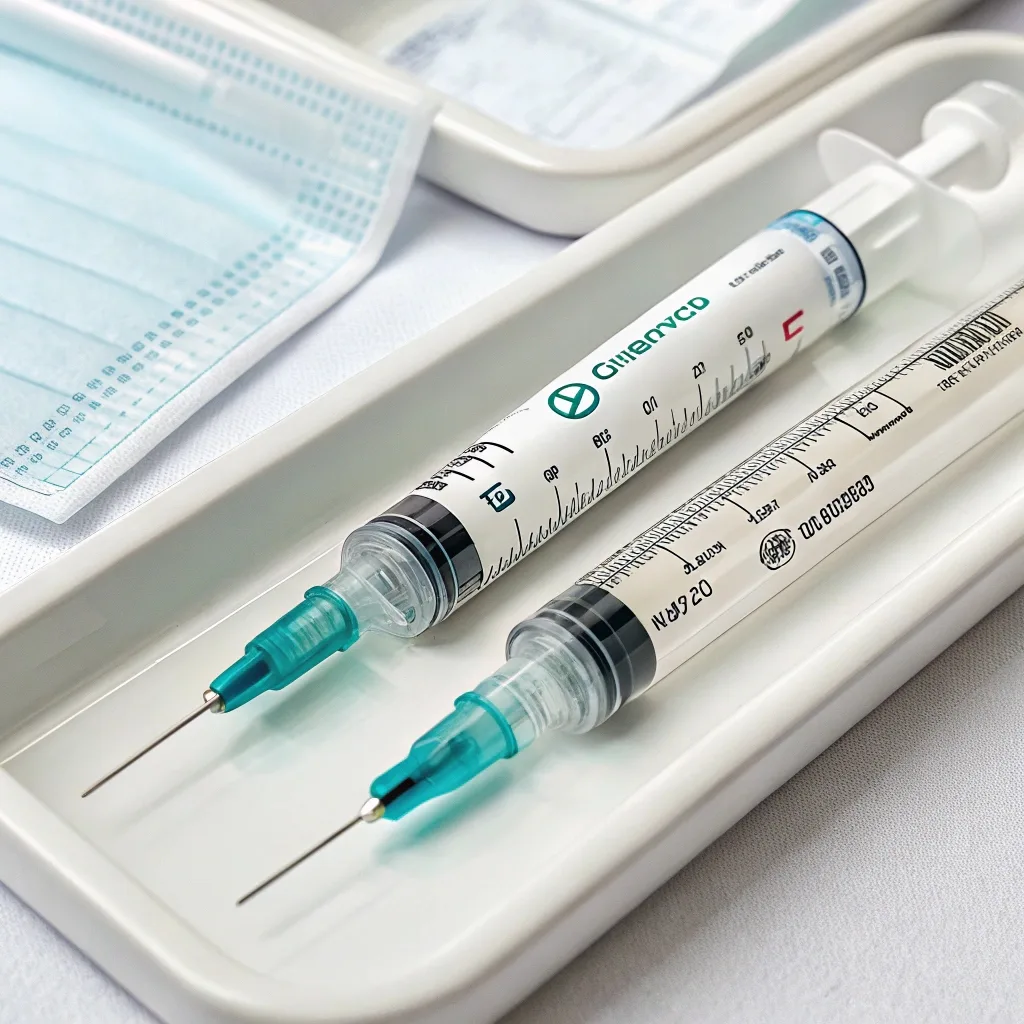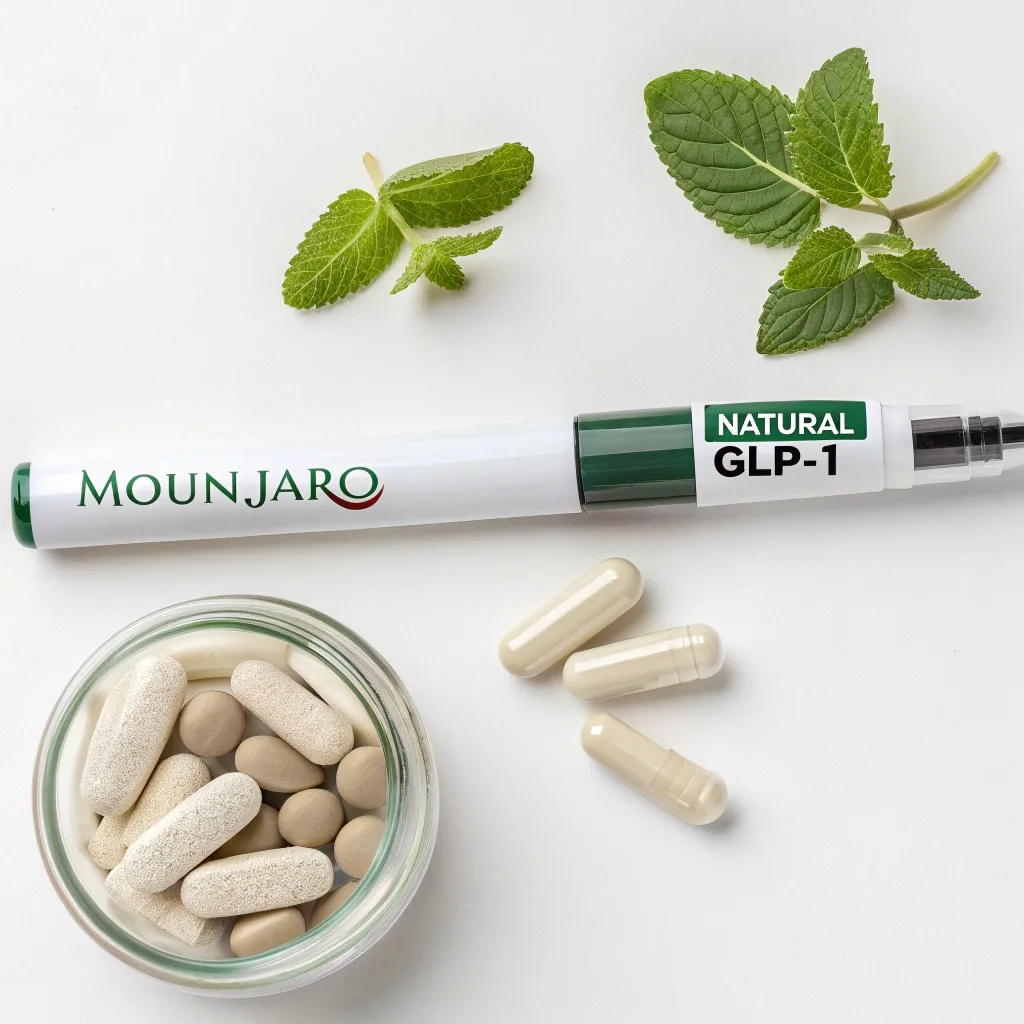GLP-1 agonist drugs like Ozempic (semaglutide) and Wegovy are changing obesity treatment, but not everyone wants injections or high costs. Enter “natural Mounjaro”—a trending term for herbal or over-the-counter alternatives that claim to replicate similar effects. But can supplements truly mirror the metabolic impact of pharmaceutical GLP-1s? This article reviews current scientific data, effectiveness, safety, cost considerations, and long-term health implications of natural compounds mimicking GLP-1 compared to FDA-approved injectable therapies.
Table of Content
Table of Contents
Natural Mounjaro vs Ozempic and Wegovy: Full Scientific Comparison
Mechanisms of Action – How Each Approach Influences Metabolic Regulation
The term “natural Mounjaro” has emerged as a catch-all for nutraceuticals, herbal supplements, and dietary compounds marketed as mimics of tirzepatide, the active ingredient in Mounjaro. These natural alternatives are not pharmaceuticals but claim to interact with metabolic pathways similar to GLP-1 or GIP analogs. Frequently promoted compounds include berberine, bitter melon extract, chromium picolinate, and inulin fiber.
Berberine, an alkaloid extracted from plants like Berberis aristata, has been shown in animal models and small human trials to activate AMPK (adenosine monophosphate-activated protein kinase), which plays a role in insulin signaling and energy expenditure. Some studies suggest it may modestly reduce hemoglobin A1c and body weight, though its GLP-1 receptor activity is indirect and not clinically comparable to synthetic analogs.
Bitter melon (Momordica charantia) is rich in charantin and polypeptide-p compounds, which have demonstrated insulin-like effects in rodent models. However, controlled trials in humans remain inconclusive and often underpowered.
Inulin, a prebiotic soluble fiber, supports gut microbiota composition, potentially increasing endogenous GLP-1 secretion by stimulating L cells in the intestinal lining. Still, the magnitude of effect is substantially lower than pharmacological agents.
These natural agents operate on multi-target pathways but lack specificity and consistent bioavailability. Unlike Mounjaro, they do not bind directly to the GLP-1 or GIP receptors, limiting their ability to achieve similar satiety or insulinotropic outcomes.
Ozempic and Wegovy – GLP-1 Receptor Agonism with Clinical Precision

Ozempic (semaglutide) and Wegovy are synthetic GLP-1 receptor agonists developed to modulate glucose metabolism, reduce appetite, and slow gastric emptying. Ozempic is approved for type 2 diabetes, while Wegovy is specifically indicated for chronic weight management in adults with obesity or weight-related comorbidities.
Mounjaro (tirzepatide) is a dual agonist of GLP-1 and GIP receptors, a class known as “twincretins.” It enhances insulin secretion in a glucose-dependent manner, suppresses glucagon, and increases satiety by modulating neuroendocrine signals in the hypothalamus.
These drugs are administered via subcutaneous injection once weekly. Their pharmacokinetics have been extensively studied, with predictable dose-response relationships and established half-lives. The mechanism of action is well-defined: they bind to human GLP-1 receptors, mimicking endogenous incretins and achieving clinically significant reductions in body weight and HbA1c.
Unlike natural agents, these medications are subject to randomized controlled trials (RCTs), FDA scrutiny, and post-marketing surveillance, providing a robust framework for efficacy and safety assessment.
Comparative Effectiveness – Clinical Outcomes vs. Natural Interventions
Weight Loss Outcomes with Prescription GLP-1 Therapies
The effectiveness of prescription GLP-1 receptor agonists in reducing body weight is well-documented across multiple randomized controlled trials and meta-analyses. These agents work by modulating satiety centers in the hypothalamus, delaying gastric emptying, and improving glycemic control—all of which contribute to sustained caloric deficit and fat mass reduction.
Many natural GLP-1 mimetics like berberine and bitter melon are available without a prescription. High-quality blends like this one available on Amazon typically cost between $20–$60/month, making them significantly more affordable than branded injections.
In the STEP-1 trial, adults with obesity treated with Wegovy (semaglutide) lost an average of 14.9% of their initial body weight over 68 weeks, compared to 2.4% with placebo. The treatment group also demonstrated improvements in waist circumference, blood pressure, and lipid profiles.
Ozempic, while originally approved for type 2 diabetes, has shown significant secondary benefits in weight reduction. Participants in the SUSTAIN-6 trial lost an average of 4.5 to 6.5 kg over 30–40 weeks, depending on baseline weight and dosing.
Mounjaro (tirzepatide) has set new benchmarks in clinical obesity pharmacotherapy. The SURMOUNT-1 trial revealed a mean weight loss of up to 21.1% in non-diabetic participants over 72 weeks, a figure previously unmatched by any FDA-approved monotherapy.
These outcomes are achieved under standardized dosing regimens, supervised titration protocols, and in combination with lifestyle modifications—creating a reproducible and scalable treatment model for metabolic disorders.
Weight Modulation with Natural Compounds and Nutraceuticals

In contrast, natural alternatives marketed as “natural Mounjaro” exhibit modest and variable effects on body weight. The heterogeneity in study design, lack of regulatory oversight, and absence of long-term data limit their utility as a substitute for GLP-1 analogs.
Berberine has demonstrated some efficacy in reducing body weight, with meta-analyses indicating an average weight loss of 2 to 5 kg over 8 to 12 weeks, typically in individuals with type 2 diabetes or insulin resistance. However, the mechanisms are indirect and often depend on concurrent dietary improvements.
Bitter melon and chromium picolinate have been investigated primarily for glycemic control, with little high-quality evidence supporting weight loss. When any effect is noted, it’s typically minor (1–2% body mass), with unclear significance.
Furthermore, natural agents lack pharmacodynamic consistency. Factors like absorption, formulation quality, and dosing variability result in unpredictable outcomes between individuals and products.
In short, while nutraceuticals may support mild metabolic improvements, they do not replicate the magnitude or reliability of weight loss achieved through semaglutide or tirzepatide. These natural strategies may be useful adjuncts for prevention or for individuals not eligible for pharmacologic therapy, but should not be mistaken as clinical equivalents.
Safety Profiles – Adverse Effects and Risk Management
Pharmacologic GLP-1 Agents – Gastrointestinal Side Effects and Regulatory Oversight
The safety of GLP-1 receptor agonists such as semaglutide (Ozempic/Wegovy) and tirzepatide (Mounjaro) has been extensively evaluated in large-scale, long-duration clinical trials. These agents are generally well-tolerated, but carry specific risk profiles that require clinical monitoring.
The most common adverse effects are gastrointestinal and occur in a dose-dependent fashion:
- Nausea
- Vomiting
- Diarrhea
- Constipation
- Abdominal pain
These symptoms typically occur during dose escalation and often diminish over time. However, in some patients, they may lead to discontinuation of therapy.
Serious but rare risks include:
- Pancreatitis (inflammation of the pancreas)
- Gallbladder disease
- Acute kidney injury, usually in the context of dehydration from GI symptoms
Additionally, both semaglutide and tirzepatide carry an FDA-mandated black box warning due to observed thyroid C-cell tumors in rodent studies. Although not confirmed in humans, this contraindicates use in individuals with a personal or family history of medullary thyroid carcinoma or multiple endocrine neoplasia syndrome type 2 (MEN2).
Despite these concerns, ongoing surveillance from post-marketing studies and extensive RCT data (STEP, SUSTAIN, SURPASS, and SURMOUNT trials) have reaffirmed the favorable safety-to-benefit ratio, especially when therapy is appropriately monitored.
Natural Compounds – Perceived Safety and Supplement Industry Challenges
Natural alternatives are often marketed as “safer” due to their non-pharmaceutical origin. While generally associated with fewer acute side effects, natural does not always mean risk-free.
Berberine, for example, can cause:
- Gastrointestinal upset (flatulence, diarrhea, constipation)
- Hypoglycemia when combined with other glucose-lowering agents
- Cytochrome P450 interactions, potentially altering metabolism of other medications
Similarly, bitter melon has been associated with:
- Hypoglycemia in sensitive individuals
- Liver enzyme elevation in rare cases
- Uterine contractions (contraindicated in pregnancy)
A critical issue in natural therapies is the lack of standardization. The FDA does not regulate supplements with the same rigor as pharmaceuticals. This opens the door to:
- Mislabeling of active ingredients
- Variability in dosage per capsule
- Contaminants or adulterants in poorly manufactured brands
This lack of consistency in formulation and purity creates potential safety risks, especially when supplements are used unsupervised or in combination with prescription medications.
In sum, while natural alternatives may appear safer on the surface, the absence of clinical oversight, regulatory testing, and pharmacokinetic data makes them less predictable—and potentially less safe—when used inappropriately.
| Aspect | Prescription GLP-1 Therapies (Ozempic, Wegovy, Mounjaro) | Natural Mounjaro Alternatives |
|---|---|---|
| Common Side Effects | Nausea, vomiting, diarrhea, constipation, abdominal pain | GI upset (berberine), hypoglycemia (when combined with other agents) |
| Serious Risks | Pancreatitis, gallbladder disease, acute kidney injury, thyroid tumor warning (black box) | Rare liver enzyme elevations, uterine contractions (bitter melon), CYP450 interactions |
| Regulatory Oversight | FDA-approved; extensive trial data and post-marketing surveillance | Not FDA-regulated; variable quality and labeling inconsistencies |
| Clinical Monitoring | Required; dosage adjustments and labs guided by physician | Generally self-directed; no standard dosing or clinical oversight |
| Long-Term Safety Data | Robust data from STEP, SURMOUNT, and SUSTAIN trials | Limited human trial data; mostly short-term studies or anecdotal |
Practical Considerations – Accessibility, Cost, and Treatment Adherence
Injections – Clinically Guided but Financially Demanding
Prescription GLP-1 therapies such as Ozempic, Wegovy, and Mounjaro offer powerful, research-backed metabolic benefits—but they come at a cost that many find prohibitive. The average monthly retail price ranges from $1,000 to $1,400 without insurance. Even with partial insurance coverage, co-pays and prior authorization hurdles can be considerable.
Patients must also factor in the need for ongoing clinical supervision, including:
- Routine lab monitoring (HbA1c, kidney function)
- Office visits for prescription refills and titration
- Adherence to lifestyle interventions (diet/exercise)
These medications are administered via subcutaneous injection once per week, requiring proper storage and handling. Some patients report injection fatigue or difficulty with administration, though auto-injectors have improved ease of use.
Still, adherence rates for GLP-1 therapies are relatively high due to the strong satiety effects and visible weight loss results, both of which reinforce ongoing use.
From a clinical standpoint, these therapies offer a structured, accountable, and outcome-driven approach to chronic weight management—but one that comes with financial and logistical burdens for many individuals.
Natural Options – Affordable and Accessible, But Inconsistent
By comparison, “natural Mounjaro” supplements and related nutraceuticals are widely available over the counter and online. Common formulations include berberine, inulin, bitter melon extract, and chromium-based blends. These typically cost $20 to $60 per month, making them far more economical and accessible than injectable therapies.
There’s no need for prescriptions, no insurance involvement, and no clinical visits—a major advantage for those without healthcare coverage or access to obesity specialists.
However, this convenience is paired with greater variability:
- No universal dosing standards
- Potential discrepancies in quality and active ingredient concentrations
- Reliance on self-education, online guidance, or influencer marketing
Moreover, motivation and adherence may be weaker due to slower or inconsistent results. Unlike GLP-1 medications, which produce noticeable satiety within weeks, natural compounds may take longer and require stricter dietary discipline to show any measurable change.
In essence, while natural options win on cost and accessibility, they require significantly more effort from the user, and come with less certainty in both short-term and long-term outcomes.
Frequently Asked Questions
1. Are natural GLP-1 mimetics as effective as Ozempic or Wegovy?
No. Natural GLP-1 mimetics such as berberine, inulin, and bitter melon have demonstrated modest metabolic effects in some studies, but they do not directly bind to GLP-1 receptors like Ozempic, Wegovy, or Mounjaro. Clinical trials of prescription therapies show average weight loss between 14–21%, whereas natural compounds typically show 2–5% reductions under optimal conditions. The biochemical potency and effect size are not comparable.
2. What are the known risks of using natural compounds compared to injectable GLP-1 therapies?
GLP-1 medications carry well-documented side effects—primarily gastrointestinal (nausea, vomiting, diarrhea)—and are regulated by the FDA. Rare but serious risks include pancreatitis and a black box warning for thyroid tumors. Natural compounds are perceived as safer but can still cause GI distress, liver enzyme elevations, or interact with other drugs (especially berberine). Moreover, supplement quality varies, and lack of regulation increases risk of underdosing, contamination, or mislabeling.
3. Can lifestyle and nutraceuticals achieve comparable outcomes to GLP-1 pharmacotherapy?
In select individuals with mild metabolic dysfunction, structured diet, exercise, and targeted supplementation may achieve meaningful improvements in body composition and insulin sensitivity. However, for individuals with clinical obesity, metabolic syndrome, or insulin resistance, GLP-1 pharmacotherapy produces more consistent, rapid, and significant outcomes than lifestyle changes alone. A combination approach may offer the best of both worlds.
4. Which is more sustainable for long-term metabolic health: medications or natural pathways?
This depends on the individual. GLP-1 therapies require long-term commitment, clinical follow-up, and cost but are highly effective. Natural pathways may be more sustainable financially, with fewer systemic side effects, but their effectiveness depends on behavioral consistency and nutritional context. In both cases, weight regain is possible without ongoing lifestyle support. Optimal sustainability lies in combining metabolic tools with long-term habit formation.
Conclusion: Clinical vs. Nutritional Modulation of GLP-1 – What’s Right for You?
Choosing between natural Mounjaro alternatives and injectable GLP-1 medications like Ozempic and Wegovy involves weighing clinical efficacy against accessibility, safety, and personal preference. Prescription therapies offer unparalleled weight loss outcomes and metabolic benefits, but require medical oversight and substantial financial investment. Natural compounds may support mild improvements in insulin sensitivity and appetite regulation, but lack the robust and reproducible outcomes seen in clinical trials. Ultimately, the most effective strategy depends on individual goals, risk factors, and readiness for lifestyle change. For those seeking maximal, evidence-based outcomes, GLP-1 medications remain the gold standard—yet natural approaches may serve as valuable adjuncts or preventive tools.

